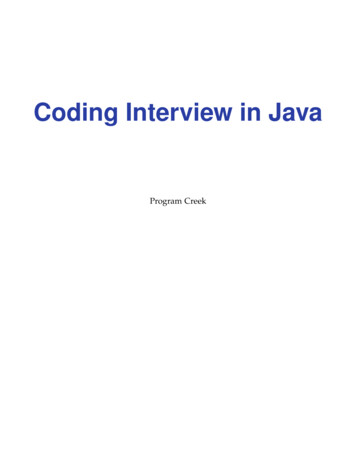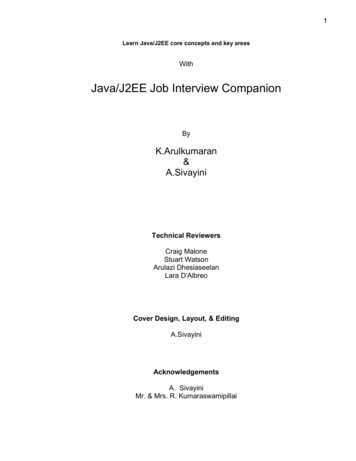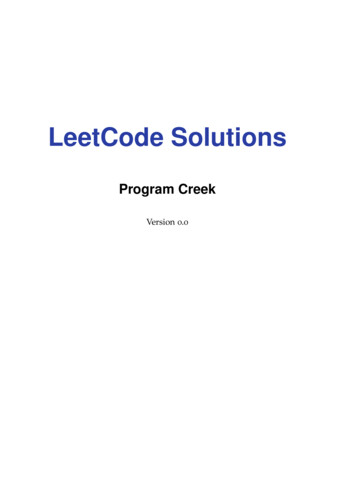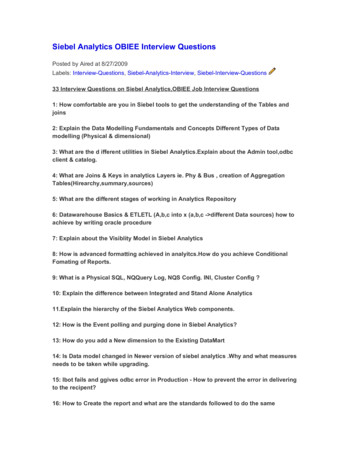
Transcription
Coding Interview in JavaProgram Creek
Contents1Remove Duplicates from Sorted Array142Remove Duplicates from Sorted Array II163Remove Element184Move Zeroes195Candy206Trapping Rain Water227Product of Array Except Self248Minimum Size Subarray Sum269Summary Ranges2810 Missing Ranges2911 Merge Intervals3012 Insert Interval3113 Partition Labels3414 Find And Replace in String3615 One Edit Distance3716 Merge Sorted Array3817 Is Subsequence4018 Backspace String Compare4119 Repeated String Match4320 Container With Most Water4421 Reverse Vowels of a String4522 Valid Palindrome4623 Shortest Word Distance4724 Shortest Word Distance II482 568
Contents25 Shortest Word Distance III5026 Intersection of Two Arrays5227 Intersection of Two Arrays II5428 Two Sum II Input array is sorted5629 Two Sum III Data structure design5730 3Sum5831 4Sum6032 3Sum Closest6233 Wiggle Sort6334 Wiggle Subsequence6435 Longest Common Prefix6536 Next Permutation6637 Search Insert Position6838 Median of Two Sorted Arrays7039 Find Minimum in Rotated Sorted Array7240 Find Minimum in Rotated Sorted Array II7441 Find First and Last Position of Element in Sorted Array7642 Guess Number Higher or Lower7843 First Bad Version8044 Search in Rotated Sorted Array8245 Search in Rotated Sorted Array II8446 Longest Increasing Subsequence8547 Count of Smaller Numbers After Self8848 Russian Doll Envelopes9149 HIndex9350 HIndex II9551 Valid Anagram9652 Group Shifted Strings9853 Palindrome Pairs10054 Line Reflection102Program Creek3 568
Contents55 Isomorphic Strings10356 Two Sum10457 Maximum Size Subarray Sum Equals k10558 Subarray Sum Equals K10759 Maximum Subarray10860 Maximum Product Subarray11161 Longest Substring Without Repeating Characters11262 Longest Substring with At Most K Distinct Characters11463 Substring with Concatenation of All Words11664 Minimum Window Substring11865 Longest Substring with At Least K Repeating Characters12066 Permutation in String12267 Longest Consecutive Sequence12468 Majority Element12669 Majority Element II12870 Increasing Triplet Subsequence12971 Find the Second Largest Number in an Array13172 Word Ladder13273 Word Ladder II13474 Top K Frequent Elements13675 Meeting Rooms II13976 Meeting Rooms14177 Range Addition14278 Merge K Sorted Arrays in Java14479 Merge k Sorted Lists14680 Rearrange String k Distance Apart14781 Minimum Cost to Hire K Workers14982 Contains Duplicate15183 Contains Duplicate II15284 Contains Duplicate III153Program Creek4 568
Contents85 Max Sum of Rectangle No Larger Than K15586 Maximum Sum of Subarray Close to K15887 Sliding Window Maximum16088 Moving Average from Data Stream16289 Find Median from Data Stream16390 Data Stream as Disjoint Intervals16591 Linked List Random Node16792 Shuffle an Array16893 Sort List17094 Quicksort Array in Java17295 Kth Largest Element in an Array17596 Sort Colors17797 Maximum Gap17898 Group Anagrams18099 Ugly Number181100 Ugly Number II182101 Super Ugly Number183102 Find K Pairs with Smallest Sums184103 Rotate Array in Java185104 Reverse Words in a String II188105 Missing Number189106 Find the Duplicate Number190107 First Missing Positive192108 Queue Reconstruction by Height194109 Binary Watch195110 Search a 2D Matrix198111 Search a 2D Matrix II199112 Kth Smallest Element in a Sorted Matrix201113 Design Snake Game203114 Number of Islands II205Program Creek5 568
Contents115 Number of Connected Components in an Undirected Graph207116 Most Stones Removed with Same Row or Column210117 Longest Increasing Path in a Matrix213118 Word Search216119 Word Search II219120 Number of Islands223121 Find a Path in a Matrix226122 Sudoku Solver228123 Valid Sudoku231124 Walls and Gates233125 Surrounded Regions236126 Set Matrix Zeroes240127 Spiral Matrix243128 Spiral Matrix II247129 Rotate Image249130 Range Sum Query 2D Immutable250131 Shortest Distance from All Buildings253132 Best Meeting Point255133 Game of Life256134 TicTacToe258135 Sparse Matrix Multiplication261136 Add Two Numbers263137 Reorder List265138 Linked List Cycle269139 Copy List with Random Pointer270140 Merge Two Sorted Lists272141 Odd Even Linked List274142 Remove Duplicates from Sorted List276143 Remove Duplicates from Sorted List II278144 Partition List279Program Creek6 568
Contents145 Intersection of Two Linked Lists280146 Remove Linked List Elements282147 Swap Nodes in Pairs283148 Reverse Linked List285149 Reverse Linked List II287150 Reverse Double Linked List289151 Remove Nth Node From End of List291152 Palindrome Linked List293153 Delete Node in a Linked List296154 Reverse Nodes in kGroup297155 Plus One Linked List300156 Binary Tree Preorder Traversal302157 Binary Tree Inorder Traversal303158 Binary Tree Postorder Traversal305159 Binary Tree Level Order Traversal308160 Binary Tree Level Order Traversal II310161 Binary Tree Vertical Order Traversal312162 Invert Binary Tree314163 Kth Smallest Element in a BST315164 Binary Tree Longest Consecutive Sequence317165 Validate Binary Search Tree319166 Flatten Binary Tree to Linked List321167 Path Sum323168 Path Sum II325169 Construct Binary Tree from Inorder and Postorder Traversal327170 Construct Binary Tree from Preorder and Inorder Traversal329171 Convert Sorted Array to Binary Search Tree331172 Convert Sorted List to Binary Search Tree332173 Minimum Depth of Binary Tree334174 Binary Tree Maximum Path Sum336Program Creek7 568
Contents175 Balanced Binary Tree337176 Symmetric Tree339177 Binary Search Tree Iterator340178 Binary Tree Right Side View342179 Lowest Common Ancestor of a Binary Search Tree344180 Lowest Common Ancestor of a Binary Tree345181 Most Frequent Subtree Sum347182 Verify Preorder Serialization of a Binary Tree349183 Populating Next Right Pointers in Each Node351184 Populating Next Right Pointers in Each Node II354185 Unique Binary Search Trees356186 Unique Binary Search Trees II358187 Sum Root to Leaf Numbers360188 Count Complete Tree Nodes362189 Closest Binary Search Tree Value365190 Binary Tree Paths367191 Maximum Depth of Binary Tree369192 Recover Binary Search Tree370193 Same Tree371194 Serialize and Deserialize Binary Tree372195 Inorder Successor in BST375196 Inorder Successor in BST II376197 Find Leaves of Binary Tree378198 Largest BST Subtree380199 Implement Trie (Prefix Tree)382200 Add and Search Word Data structure design386201 Range Sum Query Mutable390202 The Skyline Problem394203 Implement Stack using Queues396204 Implement Queue using Stacks398Program Creek8 568
Contents205 Implement a Stack Using an Array in Java399206 Implement a Queue using an Array in Java401207 Evaluate Reverse Polish Notation403208 Valid Parentheses406209 Longest Valid Parentheses407210 Min Stack408211 Max Chunks To Make Sorted410212 Maximal Rectangle411213 Mini Parser413214 Flatten Nested List Iterator415215 Nested List Weight Sum417216 Nested List Weight Sum II419217 Decode String421218 Evaluate math expression with plus, minus and parentheses423219 Partition to K Equal Sum Subsets425220 Permutations427221 Permutations II430222 Permutation Sequence432223 Number of Squareful Arrays434224 Generate Parentheses437225 Combination Sum439226 Combination Sum II441227 Combination Sum III442228 Combination Sum IV443229 Wildcard Matching444230 Regular Expression Matching445231 Expressive Words448232 Get Target Number Using Number List and Arithmetic Operations450233 Flip Game452234 Flip Game II453Program Creek9 568
Contents235 Word Pattern454236 Word Pattern II455237 Scramble String457238 Remove Invalid Parentheses458239 Shortest Palindrome460240 Lexicographical Numbers462241 Combinations464242 Letter Combinations of a Phone Number465243 Restore IP Addresses467244 Factor Combinations469245 Subsets470246 Subsets II472247 Coin Change474248 Palindrome Partitioning477249 Palindrome Partitioning II479250 House Robber480251 House Robber II482252 House Robber III483253 Jump Game484254 Jump Game II486255 Best Time to Buy and Sell Stock487256 Best Time to Buy and Sell Stock II488257 Best Time to Buy and Sell Stock III489258 Best Time to Buy and Sell Stock IV491259 Dungeon Game493260 Decode Ways494261 Perfect Squares495262 Word Break496263 Word Break II499264 Minimum Window Subsequence502Program Creek10 568
Contents265 Maximal Square503266 Minimum Path Sum505267 Unique Paths507268 Unique Paths II509269 Paint House511270 Paint House II513271 Edit Distance in Java515272 Distinct Subsequences Total518273 Longest Palindromic Substring520274 Longest Common Subsequence522275 Longest Common Substring524276 LRU Cache526277 Insert Delete GetRandom O(1)529278 Insert Delete GetRandom O(1) Duplicates allowed531279 Design a Data Structure with Insert, Delete and GetMostFrequent of O(1)533280 Design Phone Directory536281 Design Twitter537282 Single Number540283 Single Number II541284 Twitter Codility Problem Max Binary Gap542285 Number of 1 Bits544286 Reverse Bits545287 Repeated DNA Sequences546288 Bitwise AND of Numbers Range548289 Sum of Two Integers549290 Counting Bits550291 Maximum Product of Word Lengths552292 Gray Code553293 UTF8 Validation554294 Course Schedule555Program Creek11 568
Contents295 Course Schedule II558296 Minimum Height Trees560297 Graph Valid Tree562298 Clone Graph564299 Reconstruct Itinerary567300 Pow(x, n)568Program Creek12 568
ContentsEvery title in the PDF is linked back to the original blog. When it is clicked, it opens the original post in yourbrowser. If you want to discuss any problem, please go to the post and leave your comment there.I’m not an expert and some solutions may not be optimal. So please leave your comment if you see any problemor have a better solution. I will reply your comment as soon as I can.This collection is updated from time to time. Please check out this link for the latest version: ng-interview/Program Creek13 568
1 Remove Duplicates from Sorted ArrayGiven a sorted array, remove the duplicates in place such that each element appear only once and return the newlength. Do not allocate extra space for another array, you must do this in place with constant memory.For example, given input array A [1,1,2], your function should return length 2, and A is now [1,2].1.1 AnalysisThe problem is pretty straightforward. It returns the length of the array with unique elements, but the originalarray need to be changed also. This problem is similar to Remove Duplicates from Sorted Array II.1.2 Java Solutionpublic static int removeDuplicates(int[] A) {if (A.length 2)return A.length;int j 0;int i 1;while (i A.length) {if (A[i] ! A[j]) {j ;A[j] A[i];}i ;}return j 1;}14 568
1 Remove Duplicates from Sorted ArrayNote that we only care about the first unique part of the original array. So it is ok if input array is 1, 2, 2, 3, 3,the array is changed to 1, 2, 3, 3, 3.Program Creek15 568
2 Remove Duplicates from Sorted Array IIFollow up for "Remove Duplicates": What if duplicates are allowed at most twice?For example, given sorted array A [1,1,1,2,2,3], your function should return length 5, and A is now [1,1,2,2,3].So this problem also requires in-place array manipulation.2.1 Java Solution 1We can not change the given array’s size, so we only change the first k elements of the array which has duplicatesremoved.public int removeDuplicates(int[] nums) {if(nums null){return 0;}if(nums.length 3){return nums.length;}int i 0;int j 1;/*step1step2step3step4i, j0 11 21 32 41 1 1 2 2 3i ji ji ji j*/while(j nums.length){if(nums[j] nums[i]){if(i 0){i ;j ;}else if(nums[i] nums[i-1]){j ;}else{i ;nums[i] nums[j];j ;}}else{i ;nums[i] nums[j];j ;}}return i 1;}16 568
2 Remove Duplicates from Sorted Array IIThe problem with this solution is that there are 4 cases to handle. If we shift our two points to right by 1element, the solution can be simplified as the Solution 2.2.2 Java Solution 2public int removeDuplicates(int[] nums) {if(nums null){return 0;}if (nums.length 2){return nums.length;}/*1,1,1,2,2,3i j*/int i 1; // point to previousint j 2; // point to currentwhile (j nums.length) {if (nums[j] nums[i] && nums[j] nums[i - 1]) {j ;} else {i ;nums[i] nums[j];j ;}}return i 1;}Program Creek17 568
3 Remove ElementGiven an array and a value, remove all instances of that value in place and return the new length. (Note: Theorder of elements can be changed. It doesn’t matter what you leave beyond the new length.)3.1 Java SolutionThis problem can be solve by using two indices.public int removeElement(int[] A, int elem) {int i 0;int j 0;while(j A.length){if(A[j] ! elem){A[i] A[j];i ;}j ;}return i;}18 568
4 Move ZeroesGiven an array nums, write a function to move all 0’s to the end of it while maintaining the relative order of thenon-zero elements.For example, given nums [0, 1, 0, 3, 12], after calling your function, nums should be [1, 3, 12, 0, 0].4.1 Java Solution 2We can use the similar code that is used to solve Remove Duplicates from Sorted Array I, II, Remove Element.public void moveZeroes(int[] nums) {int i 0;int j 0;while(j nums.length){if(nums[j] 0){j ;}else{nums[i] nums[j];i ;j ;}}while(i nums.length){nums[i] 0;i ;}}19 568
5 CandyThere are N children standing in a line. Each child is assigned a rating value. You are giving candies to thesechildren subjected to the following requirements:1. Each child must have at least one candy. 2. Children with a higher rating get more candies than theirneighbors.What is the minimum candies you must give?5.1 AnalysisThis problem can be solved in O(n) time.We can always assign a neighbor with 1 more if the neighbor has higher a rating value. However, to get theminimum total number, we should always start adding 1s in the ascending order. We can solve this problem byscanning the array from both sides. First, scan the array from left to right, and assign values for all the ascendingpairs. Then scan from right to left and assign values to descending pairs.This problem is similar to Trapping Rain Water.5.2 Java Solutionpublic int candy(int[] ratings) {if (ratings null ratings.length 0) {return 0;}int[] candies new int[ratings.length];candies[0] 1;//from let to rightfor (int i 1; i ratings.length; i ) {if (ratings[i] ratings[i - 1]) {candies[i] candies[i - 1] 1;} else {// if not ascending, assign 1candies[i] 1;}}int result candies[ratings.length - 1];//from right to leftfor (int i ratings.length - 2; i 0; i--) {int cur 1;if (ratings[i] ratings[i 1]) {cur candies[i 1] 1;}result Math.max(cur, candies[i]);candies[i] cur;}20 568
5 Candyreturn result;}Program Creek21 568
6 Trapping Rain WaterGiven n non-negative integers representing an elevation map where the width of each bar is 1, compute howmuch water it is able to trap after raining.For example, given [0,1,0,2,1,0,1,3,2,1,2,1], return 6.6.1 AnalysisThis problem is similar to Candy. It can be solve by scanning from both sides and then get the total.6.2 Java Solutionpublic int trap(int[] height) {int result 0;if(height null height.length 2)return result;int left[] new int[height.length];int right[] new int[height.length];//scan from left to rightint max height[0];left[0] height[0];for(int i 1; i height.length; i ){if(height[i] max){left[i] max;22 568
6 Trapping Rain Water}else{left[i] height[i];max height[i];}}//scan from right to leftmax height[height.length-1];right[height.length-1] height[height.length-1];for(int i height.length-2; i 0; i--){if(height[i] max){right[i] max;}else{right[i] height[i];max height[i];}}//calculate totoalfor(int i 0; i height.length; i ){result Math.min(left[i],right[i])-height[i];}return result;}Program Creek23 568
7 Product of Array Except SelfGiven an array of n integers where n 1, nums, return an array output such that output[i] is equal to the productof all the elements of nums except nums[i].Solve it without division and in O(n).For example, given [1,2,3,4], return [24,12,8,6].7.1 Java Solution 1public int[] productExceptSelf(int[] nums) {int[] result new int[nums.length];int[] t1 new int[nums.length];int[] t2 new int[nums.length];t1[0] 1;t2[nums.length-1] 1;//scan from left to rightfor(int i 0; i nums.length-1; i ){t1[i 1] nums[i] * t1[i];}//scan from right to leftfor(int i nums.length-1; i 0; i--){t2[i-1] t2[i] * nums[i];}//multiplyfor(int i 0; i nums.length; i ){result[i] t1[i] * t2[i];}return result;}7.2 Java Solution 2We can directly put the product values into the final result array. This saves the extra space to store the 2intermediate arrays in Solution 1.public int[] productExceptSelf(int[] nums) {int[] result new int[nums.length];result[nums.length-1] 1;for(int i nums.length-2; i 0; i--){result[i] result[i 1]*nums[i 1];}24 568
7 Product of Array Except Selfint left 1;for(int i 0; i nums.length; i ){result[i] result[i]*left;left left*nums[i];}return result;}Program Creek25 568
8 Minimum Size Subarray SumGiven an array of n positive integers and a positive integer s, find the minimal length of a subarray of which thesum s. If there isn’t one, return 0 instead.For example, given the array [2,3,1,2,4,3] and s 7, the subarray [4,3] has the minimal length of 2 under theproblem constraint.8.1 AnalysisWe can use 2 points to mark the left and right boundaries of the sliding window. When the sum is greater thanthe target, shift the left pointer; when the sum is less than the target, shift the right pointer.8.2 Java Solution - two pointersA simple sliding window solution.public int minSubArrayLen(int s, int[] nums) {if(nums null nums.length 1)return 0;int result nums.length;int start 0;int sum 0;int i 0;boolean exists false;while(i nums.length){if(sum s){exists true; //mark if there exists such a subarrayif(start i-1){return 1;}result Math.min(result, i-start);sum sum-nums[start];start ;}else{if(i nums.length)break;sum sum nums[i];i ;}}if(exists)return result;elsereturn 0;26 568
8 Minimum Size Subarray Sum}Similarly, we can also write it in a more readable way.public int minSubArrayLen(int s, int[] nums) {if(nums null nums.length 0)return 0;int i 0;int j 0;int sum 0;int minLen Integer.MAX VALUE;while(j nums.length){if(sum s){sum nums[j];j ;}else{minLen Math.min(minLen, j-i);if(i j-1)return 1;sum - nums[i];i ;}}while(sum s){minLen Math.min(minLen, j-i);sum - nums[i ];}return minLen Integer.MAX VALUE? 0: minLen;}Program Creek27 568
9 Summary RangesGiven a sorted integer array without duplicates, return the summary of its ranges for consecutive numbers.For example, given [0,1,2,4,5,7], return ["0- 2","4- 5","7"].9.1 AnalysisWhen iterating over the array, two values need to be tracked: 1) the first value of a new range and 2) the previousvalue in the range.9.2 Java Solutionpublic List String summaryRanges(int[] nums) {List String result new ArrayList String ();if(nums null nums.length 0)return result;if(nums.length 1){result.add(nums[0] "");}int pre nums[0]; // previous elementint first pre; // first element of each rangefor(int i 1; i nums.length; i ){if(nums[i] pre 1){if(i nums.length-1){result.add(first "- " nums[i]);}}else{if(first pre){result.add(first "");}else{result.add(first "- " pre);}if(i nums.length-1){result.add(nums[i] "");}first nums[i];}pre nums[i];}return result;}28 568
10 Missing RangesGiven a sorted integer array nums, where the range of elements are in the inclusive range [lower, upper], returnits missing ranges.Example:Input: nums [0, 1, 3, 50, 75], lower 0 and upper 99, Output: ["2", "4- 49", "51- 74", "76- 99"]10.1 Java Solutionpublic List String findMissingRanges(int[] nums, int lower, int upper) {List String result new ArrayList ();int start lower;if(lower Integer.MAX VALUE){return result;}for(int i 0; i nums.length; i ){//handle duplicates, e.g., [1,1,1] lower 1 upper 1if(i nums.length-1 && nums[i] nums[i 1]){continue;}if(nums[i] start){start ;}else{result.add(getRange(start, nums[i]-1));if(nums[i] Integer.MAX VALUE){return result;}start nums[i] 1;}}if(start upper){result.add(getRange(start, upper));}return result;}private String getRange(int n1, int n2) {return n1 n2 ? String.valueOf(n1) : String.format("%d- %d" , n1, n2);}29 568
11 Merge IntervalsGiven a collection of intervals, merge all overlapping intervals.For example, Given [1,3],[2,6],[8,10],[15,18], return [1,6],[8,10],[15,18].11.1 AnalysisThe key to solve this problem is defining a Comparator first to sort the arraylist of Intevals.11.2 Java Solutionpublic List Interval merge(List Interval intervals) {if(intervals null intervals.size() 1){return intervals;}Collections.sort(intervals, Comparator.comparing((Interval itl)- itl.start));List Interval result new ArrayList ();Interval t intervals.get(0);for(int i 1; i intervals.size(); i ){Interval c intervals.get(i);if(c.start t.end){t.end Math.max(t.end, c.end);}else{result.add(t);t c;}}result.add(t);return result;}30 568
12 Insert IntervalProblem:Given a set of non-overlapping & sorted intervals, insert a new interval into the intervals (merge if necessary).Example 1:Given intervals [1,3],[6,9], insert and merge [2,5] in as [1,5],[6,9].Example 2:Given [1,2],[3,5],[6,7],[8,10],[12,16], insert and merge [4,9] in as [1,2],[3,10],[12,16].This is because the new interval [4,9] overlaps with [3,5],[6,7],[8,10].12.1 Java Solution 1When iterating over the list, there are three cases for the current range./*** Definition for an interval.* public class Interval {int start;*int end;*Interval() { start 0; end 0; }*Interval(int s, int e) { start s; end e; }*31 568
12 Insert Interval* }*/public class Solution {public ArrayList Interval insert(ArrayList Interval intervals, Interval newInterval) {ArrayList Interval result new ArrayList Interval ();for(Interval interval: intervals){if(interval.end newInterval.start){result.add(interval);}else if(interval.start al interval;}else if(interval.end newInterval.start interval.start newInterval.end){newInterval new Interval(Math.min(interval.start, newInterval.start),Math.max(newInterval.end, interval.end));}}result.add(newInterval);return result;}}12.2 Java Solution 2 - Binary SearchIf the intervals list is an ArrayList, we can use binary search to make the best search time complexity O(log(n)).However, the worst time is bounded by shifting the array list if a new range needs to be inserted. So timecomplexity is still O(n).public List Interval insert(List Interval intervals, Interval newInterval) {List Interval result new ArrayList ();if (intervals.size() 0) {result.add(newInterval);return result;}int p helper(intervals, newInterval);result.addAll(intervals.subList(0, p));for (int i p; i intervals.size(); i ) {Interval interval intervals.get(i);if (interval.end newInterval.start) {result.add(interval);} else if (interval.start newInterval.end) {result.add(newInterval);newInterval interval;} else if (interval.end newInterval.start interval.start newInterval.end) {newInterval new Interval(Math.min(interval.start, newInterval.start),Math.max(newInterval.end, interval.end));}}result.add(newInterval);Program Creek32 568
12 Insert Intervalreturn result;}public int helper(List Interval intervals, Interval newInterval) {int low 0;int high intervals.size() - 1;while (low high) {int mid low (high - low) / 2;if (newInterval.start intervals.get(mid).start) {high mid;} else {low mid 1;}}return high 0 ? 0 : high - 1;}The best time is O(log(n)) and worst case time is O(n).Program Creek33 568
13 Partition LabelsA string S of lowercase letters is given. We want to partition this string into as many parts as possible so that eachletter appears in at most one part, and return a list of integers representing the size of these parts.For example:Input: S "ababfeefhijkh" Output: [4,4,5]Explanation: The partition is "abab", "feef", "hijkh". This is a partition so that each letter appears in at most onepart.13.1 Java Solutionpublic List Integer partitionLabels(String S) {ArrayList Integer result new ArrayList ();HashMap Character, int[] map new HashMap ();for(int i 0; i S.length(); i ){char c S.charAt(i);int[] arr map.get(c);if(arr null){arr new int[]{i, i};map.put(c, arr);}else{arr[1] i;}}ArrayList int[] list new ArrayList , Comparator.comparing((int[] arr) - arr[0]));34 568
13 Partition Labelsint[] t list.get(0);for(int i 1; i list.size(); i ){int[] range list.get(i);if(range[1] t[1]){continue;}else if(range[0] t[1]){ //impossible be equalresult.add(t[1]-t[0] 1);t range;}else{t[1] range[1];}}result.add(t[1]-t[0] 1);return result;}Program Creek35 568
14 Find And Replace in StringTo some string S, we will perform some replacement operations that replace groups of letters with new ones (notnecessarily the same size).Each replacement operation has 3 parameters: a starting index i, a source word x and a target word y. The ruleis that if x starts at position i in the original string S, then we will replace that occurrence of x with y. If not, wedo nothing.For example, if we have S "abcd" and we have some replacement operation i 2, x "cd", y "ffff", thenbecause "cd" starts at position 2 in the original string S, we will replace it with "ffff".14.1 Java Solutionpublic String findReplaceString(String S, int[] indexes, String[] sources, String[] targets) {StringBuilder sb new StringBuilder();TreeMap Integer, String[] map new TreeMap ();for (int i 0; i indexes.length; i ) {map.put(indexes[i], new String[]{sources[i], targets[i]});}int prev 0;for (Map.Entry Integer, String[] entry : map.entrySet()) {int startIndex entry.getKey();int endIndex startIndex entry.getValue()[0].length();if (prev ! startIndex) {sb.append(S.substring(prev, startIndex));}String org S.substring(startIndex, endIndex);if (org.equals(entry.getValue()[0])) {sb.append(entry.getValue()[1]);prev endIndex;} else {sb.append(org);prev endIndex;}}if (prev S.length()) {sb.append(S.substring(prev));}return sb.toString();}36 568
15 One Edit DistanceGiven two strings S and T, determine if they are both one edit distance apart.15.1 Java Solutionpublic boolean isOneEditDistance(String s, String t) {if(s null t null)return false;int m s.length();int n t.length();if(Math.abs(m-n) 1){return false;}int i 0;int j 0;int count 0;while(i m&&j n){if(s.charAt(i) t.charAt(j)){i ;j ;}else{count ;if(count 1)return false;if(m n){i ;}else if(m n){j ;}else{i ;j ;}}}if(i m j n){count ;}if(count 1)return true;return false;}37 568
16 Merge Sorted ArrayGiven two sorted integer arrays A and B, merge B into A as one sorted array.Note: You may assume that A has enough space to hold additional elements from B. The number of elementsinitialized in A and B are m and n respectively.16.1 AnalysisThe key to solve this problem is moving element of A and B backwards. If B has some elements left after A isdone, also need to handle that case.The takeaway message from this problem is that the loop condition. This kind of condition is also used formerging two sorted linked list.16.2 Java Solution 1public class Solution {public void merge(int A[], int m, int B[], int n) {while(m 0 &&if(A[m-1] A[m n-1]m--;}else{A[m n-1]n--;}}n 0){B[n-1]){ A[m-1]; B[n-1];while(n 0){A[m n-1] B[n-1];n--;}}}16.3 Java Solution 2The loop condition also can use m n like the following.public voidint i mint j nint k mmerge(int A[], int m, int B[], int n) {- 1;- 1; n - 1;while (k 0) {if (j 0 (i 0 && A[i] B[j]))A[k--] A[i--];38 568
16 Merge Sorted ArrayelseA[k--] B[j--];}}Program Creek39 568
17 Is SubsequenceGiven a string s and a string t, check if s is subsequence of t.You may assume that there is only lower case English letters in both s and t. t is potentially a very long (length 500,000) string, and s is a short string ( 100).A subsequence of a string is a new string which is formed from the original string by deleting some (canbe none) of the characters without disturbing the relative positions of the remaining characters. (ie, "ace" is asubsequence of "abcde" while "aec" is not).17.1 Java Solutionpublic boolean isSubsequence(String s, String t) {if(s.length() 0)return true;int i 0;int j 0;while(i s.length() && j t.length()){if(s.charAt(i) t.charAt(j)){i ;}j ;if(i s.length())return true;}return false;}40 568
18 Backspace String CompareGiven two strings S and T, return if they are equal when both are typed into empty text editors. # means abackspace character.Example 1:Input: S "ab#c", T "ad#c"Output: trueExplanation: Both S and T become "ac".Example 2:Input: S "a##c", T "#a#c"Output: trueExplanation: Both S and T become "c".18.1 Java SolutionThis problem requires O(N) time and O(1) space.public boolean backspaceCompare(String S, String T) {int i S.length()-1;int j T.length()-1;while(i 0 j 0){int c1 0;while(i 0 && (c1 0 S.charAt(i) ’#’)){if(S.charAt(i) ’#’){c1 ;}else{c1--;}i--;}int c2 0;while(j 0 && (c2 0 T.charAt(j) ’#’)){if(T.charAt(j) ’#’){c2 ;}else{c2--;}j--;}if(i 0 && j 0){if(S.charAt(i)! T.charAt(j)){return false;41 568
18 Backspace String Compare}else{i--;j--;}}else{if(i 0 j 0){return false;}}}return i 0 && j 0;}Program Creek42 568
19 Repeated String MatchGiven two strings A and B, find the minimum number of times A has to be repeated such that B is a substring ofit. If no such solution, return -1.For example, with A "abcd" and B "cdabcdab".Return 3, because by repeating A three times (“abcdabcdabcd”), B is a substring of it; and B is not a substringof A repeated two times ("abcdabcd").Note: The le
103Rotate Array in Java 185 104Reverse Words in a String II 188 105Missing Number 189 . Every title in the PDF is linked back to the original blog. When it is clicked, it opens the original post in your . 10-algorithms-for-coding-interview/ Pro










